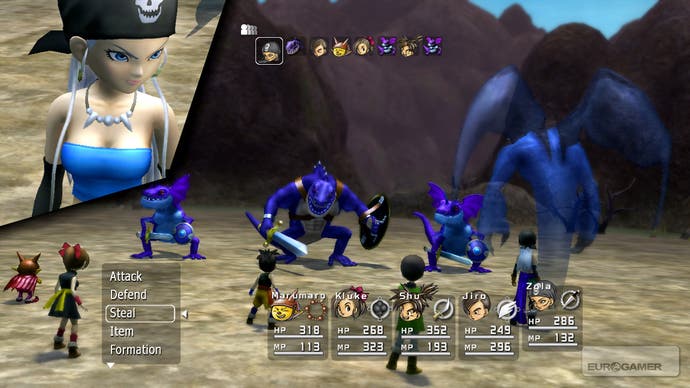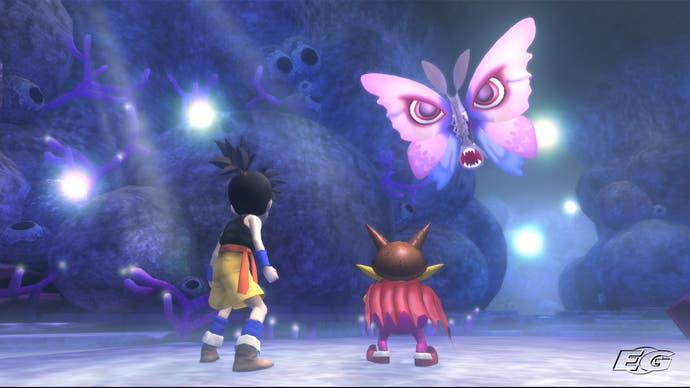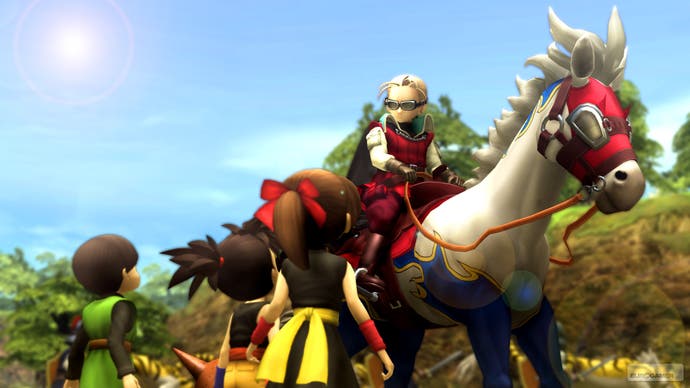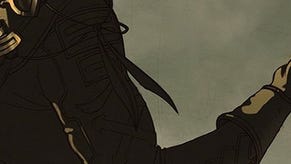Blue Dragon
Definitely feeling blue.
If anything, Blue Dragon's graphics feel almost exactly like you'd expect a very old J-RPG to look like, if it somehow popped into life. Monsters often sport cartoonish human faces, bright colours are the order of the day, and even the game's magic attacks feel strangely retro compared to the flashy, particle-effect laden spells of modern Final Fantasy titles. A water attack draws a straight column across the play area, taking out a line of enemies; fire breathes forward in a direct line. These are effects from the dawn of J-RPGs, updated but by no means evolved.
That, perhaps, is the true heart of what Sakaguchi, Toriyama and Uematsu have tried to accomplish with Blue Dragon. This is not merely a homage to simpler storytelling, or to the cartoons of yore; this is an attempt to re-create kinds of J-RPGs which this legendary trio are best known for. Toriyama's art is simple and childish, the kind of overstated designs which worked well when you only had a few pixels to play with for each character. Uematsu's music sounds much more like his early, simplistic Final Fantasy work than like the sweeping, epic scores we've become used to in recent years (although there's an utterly dreadful and misjudged rock track with English lyrics in there too, which plays during boss battles and reminds us of Sonic Adventure's woeful audio excursions). It is a joyous, unapologetic exercise in nostalgia - a look back at the early Final Fantasy and Dragon Quest titles, a sigh, and a rose tinted "gosh, weren't games just great back then?".
Because I Can't Forget

Even in the gameplay - in fact, most of all in the gameplay - this attitude seems to come through clearly. Combat is resolutely turn-based, and remains extremely traditional - despite the central conceit of the game. Each character has a mythical beast living in their shadow, such as Shu's eponymous blue dragon, which carries out magical and physical attacks at their behest; however, this is largely speaking a visual effect, rather than having any real impact on gameplay.
You can change the class of your shadow beast, which allows you to access a different set of abilities, but this is really no different to changing the class of your character directly in many old RPGs. Your shadow doesn't take damage or have any statistics which are different from your character stats; the old mainstays of RPGs, HP and MP, work exactly as you'd expect, as do elemental attacks and resistances, items, status effects and the likes.
The sole concession to progress in Blue Dragon's gameplay is that enemies appear on the world map, rather than simply dragging you into random battles unseen. You can even clear all of the enemies out of an entire dungeon, if you wish, and walk around unmolested. The game also sports a clever system which allows you to battle multiple groups of foes; if several enemies are nearby, you can pull the right trigger to select to take them all on at once.

This has a few effects on the gameplay. For a start, between each round of the battle, you get a random stat boost of some description, so you gradually power up as you go along (all of these stat boosts are negated when you've finished beating up all the foes in the battle, however). More importantly, though, some enemy types hate each other, and will fight each other rather than attacking you - so dragging them into a battle together gives you an opportunity for an easy win.
It's a clever system, and a rare stand-out in a game which is otherwise relentlessly traditional. Even the structure of the game owes much to old J-RPGs such as the early Final Fantasies; for the most part, you'll find yourself walking over large stretches of monster-infested land and then through various huge dungeons in order to get to the next five minutes of storyline. In Blue Dragon's defence, though, the game does provide warp points between areas you've previously visited; it's traditional, but it's not stupid.
After our first few hours with Blue Dragon, though, we're filled with reservations about the game. We're suckers for nostalgia, just as much as the next man - and as an exercise in nostalgia, Blue Dragon seems to be pitch perfect, effortlessly capturing the spirit of a simpler age when J-RPGs were the de facto entertainment for a generation of Japanese boys who are now in their twenties and thirties.

However, at the back of our minds, we can't shake the feeling that this nostalgia may well be meaningless to the rest of the world. Let's not forget that Japanese RPGs struggled to crack the western market until the late nineties, and that most of us outside Japan have only been exposed to the world of early JRPGs by later re-releases (many of which have been commercially ignored). It's also worth noting that Dragon Quest, a series which remains very true to its roots in a way which Final Fantasy does not, is mostly unpopular with western audiences.
Whether Blue Dragon will suffer the same fate remains to be seen. We're hugely impressed by the game as a beautifully presented, lovingly crafted exercise in nostalgia; a largely successful effort at re-creating a time when RPGs were simpler, brighter and more child-like. Balanced against that is the question of whether that's really something people outside Japan actually want to re-create, however.
We'll be trying to find out exactly where that balance lies when we review the full game a bit closer to its release date - it's currently scheduled for a September launch here in Europe.




.png?width=291&height=164&fit=crop&quality=80&format=jpg&auto=webp)




.jpg?width=291&height=164&fit=crop&quality=80&format=jpg&auto=webp)
